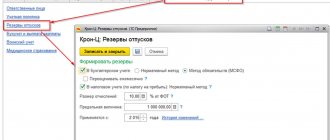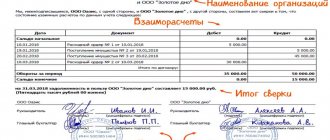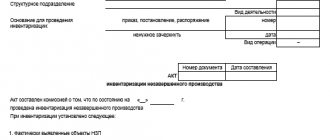Inventory procedure
The procedure by which the inventory is carried out is established in the Methodological Instructions (approved by Order of the Ministry of Finance of Russia No. 49 of June 13, 1995). It is presented in three stages:
- At the first stage, the company issues an order to conduct an inventory (form INV-22), after which it is registered in the control log for the implementation of the relevant orders (INV-23). In addition, at the first stage, an inventory commission is formed;
- At the second stage, the calculations are directly verified. To do this, account balances are opened for individual employees. After this, they consider documents confirming how legitimate the debt is in settlements for each employee;
- At the third stage, an act is drawn up (form INV-17), which reflects the balance of debts in settlements with employees that have not been documented. After this, the inventory results are entered into the INV-23 form.
Inventory of settlements, accountable amounts – Enterprise Info
In general, an inventory of settlements with accountable persons should be carried out at least once a year - before drawing up the annual balance sheet. Why it is so important to carry out an inventory of accountable amounts, what negative tax consequences it helps to avoid, and what is the procedure for conducting this inventory, you will learn further from the article.
What is the procedure for taking inventory of settlements with accountable persons?
An example of an inventory of settlements with accountable persons
Results
What is the procedure for taking inventory of settlements with accountable persons?
In accordance with clause 3.47 of Order No. 49 of the Ministry of Finance dated June 13, 1995, if an inventory of accountable amounts is carried out, the following are checked:
- reports on advances received from persons who received money for reporting (with verification of the intended use of funds);
- the amount of advances issued to the accountable person for each accountable entity (the purpose and date of issue are checked).
You will learn about the features of advance reports by studying our article “Features of advance reports in accounting .
Before starting the inventory, the manager creates a corresponding order.
It is very convenient to issue it using the INV-22 form. For information on how to fill it out, read the article “Unified form No. INV-22 - and sample” .
To carry out the inventory, a commission is created, the composition of which is specified in the order. Her responsibilities include:
- comparison of data recorded in accounting with data confirmed by primary documentation;
- search for those accountable amounts for which an advance report was not provided by the accountables;
- checking the fact of issuing advances against reporting and using the amounts in accordance with the intended purpose.
At the beginning of the inventory, the commission must check whether all the necessary administrative documents are available for settlements with accountable persons. These are local acts that are drawn up by the accounting department and approved by the director of the enterprise.
Such local acts include:
- a list of employees who have become entitled to receive accountable amounts;
- a list of persons from the management team who are entrusted to give instructions to accountable persons regarding targeted expenses, and to the accountant (cashier) - orders for the issuance of accountable amounts.
Source:
Inventory of accountable amounts
Inventory, that is, checking actual data and reconciling with accounting data, is the responsibility of each organization.
The inventory is regulated by Methodological guidelines for the inventory of property and financial obligations, which were approved by order of the Ministry of Finance of the Russian Federation dated June 13.
1995 No. 49 (hereinafter referred to as Guidelines). Inventory of settlements with accountable persons is one of the important stages of inventory.
Inventory of settlements with personnel
The list of situations when an organization is obliged to conduct an inventory is established by paragraphs 1.5, 1.6 of the Guidelines. These include the obligation to conduct an inventory before drawing up annual reports. That is, at least once a year it is necessary to check the accuracy of payments to employees:
- calculations for wages on account 70;
- settlements with accountable persons on account 71;
- calculation of taxes and contributions on wages and other income in accounts 68 and 69;
- settlements for other transactions (for example, claims, loans) on account 73.
Inventory of payroll calculations
During the inventory, the correctness of the amounts accrued to employees according to the documents and the reflection of this data in accounting are verified. To do this, it is necessary to check the compliance of the amounts paid with the provisions of local acts, employment contracts, orders, time sheets and other documents.
The importance of this stage is not only to confirm internal accounting in the organization, but also to avoid claims from employees and regulatory authorities.
In this case, the consequences can be both in the case of under-accrual and in the case of excessive accrual of wages. At the same time, as part of the inventory of settlements with personnel for wages, it is necessary to check the payment of bonuses - whether this is a mandatory payment in accordance with the regulations on the remuneration system, the regulations on bonuses.
Thus, in case of failure to pay an employee for the time worked - overtime, additional payment for combining positions and other payments, the employee can apply and recover money in court, as well as send a complaint to the State Labor Inspectorate, and during an inspection, a significant fine may be imposed on the organization under Art. . 5.
27 Code of Administrative Offences.
In the case of excessive payment to an employee, identified during the wage inventory, it will subsequently be necessary to assess the possibility of recovery, since only in strictly defined cases specified in Art. 137 of the Labor Code of the Russian Federation, it is possible to withhold overpaid funds.
In addition, excessive payments will entail tax consequences; accounting as expenses for tax purposes may be considered unlawful, therefore, if collection is impossible and the employee refuses to return the overpayment on a voluntary basis, it will be necessary to make changes to the accounting.
During the inventory process, a large area of verification consists of settlements with accountable persons.
The methodological instructions specifically highlight the verification of accountable amounts. Point 3.
47 it is established that reports on advances issued are checked for each accountable entity, taking into account the date of issue and intended purpose.
The organization must establish a list of persons who have the right to approve advance reports, persons to whom funds can be issued against the report, and deadlines for submitting the report.
Within the established period, the employee must complete the order and submit documents confirming the costs, for example, invoices for the purchase of goods, cash receipts, sales receipts, or return the funds received on account.
As part of the inventory of settlements with accountable persons, the commission must check the timing of the report for the advance received. According to clause 6.3 of the Bank of Russia Directives dated 11.03.
2014 N 3210-U “On the procedure for conducting cash transactions by legal entities and the simplified procedure for conducting cash transactions by individual entrepreneurs and small businesses” when issuing cash on account, a deadline for issuing money must be established, and the employee must report within three days after expiration established deadline. In this case, the issuance of the next advance is allowed only after a complete report for the previous one.
When checking advances on travel expenses, it is necessary to check the execution of documents, compliance with the Regulations on the specifics of sending employees on business trips, approved by Decree of the Government of the Russian Federation of October 13, 2008 N 749, the presence of an order for sending on a business trip, the correctness of the calculation of daily allowances, the availability of documents confirming travel expenses and accommodation, as well as other travel expenses.
During the inventory process, employees who did not report on time, as well as employees who reported later than the deadline, are identified.
Inventory of settlements with personnel for other operations
At this stage of the inventory, it is necessary to check account 73, which takes into account calculations for compensation of damage and calculations for loans.
When checking calculations for compensation for damage, it is necessary to find out the grounds for recovery and the correctness of execution in accordance with labor legislation - orders of the manager, acts of inventory of property, explanatory statements of the employee and other documents. Also, when taking an inventory of settlements with employees, it is necessary to check compliance with the provisions of Art. 138 of the Labor Code of the Russian Federation regarding the limitation of the amount of deductions.
When checking loan payments, you need to pay attention to debt repayment, interest accrual, and also check the need to withhold personal income tax in cases established by law.
Inventory of settlements with accountable persons
An inventory of settlements with accountable persons must be carried out at least once a year. The date is set approximately before the submission of the annual balance sheet (clause 27 of Order of the Ministry of Finance No. 34n). Read more about the procedure for taking inventory of accountable persons in this article.
The procedure for carrying out an inventory, evaluating advance documents and calculating accountable amounts are based on clause 3.47 of Order No. 49 of the Ministry of Finance. In this case, the following is checked:
- Reports on advances of persons who received funds against the report.
- Money issued on account to a person, and checking the intended purpose and clear date for issuing the advance.
Before the inventory of payments begins, the head of the enterprise is obliged to draw up an order in the INV-22 form. An example of filling out an order is “Form No. INV-22”; the sample can be downloaded and used to draw up the corresponding document.
The procedure for conducting an inventory of settlements with wards dictates certain rules. It is imperative to create a commission that will:
- Compare accounting information with data from primary documentation.
- Look for funds that are accountable and were lost or an advance report was not provided from the accountant.
- Check the facts of advances and use of funds in accordance with the specified purpose (purpose).
In addition, at the very beginning of the inventory procedure, responsible members check documents according to the advance report and orders of the owner, which must be at the enterprise and confirm the legality of the process. An inventory of local acts of the organization is carried out, which must be documented in the accounting department and must be approved by the signature of the owner of the enterprise.
Local acts:
- List of persons who have the right to receive advance funds.
- Listing of employees whose powers include instructions to accountable persons of the enterprise, as well as to an accountant or cashier, corresponding orders for the issuance of advances (accountable amounts).
One of the prerequisites for conducting an inventory of expense reports is the basis for issuing funds against the report to an employee who has submitted a written statement indicating the purpose and need for a specific amount. More details in Art. Clause 6.3 of Bank of the Russian Federation Instructions No. 3210. The accountable person must return unspent funds to the cash desk by filling out the appropriate form for depositing the accountable amount.
Next, the owner of the enterprise draws up a local act and indicates there the deadline for approval of the advance report by the accounting department. This act must be included in the list of papers for the inventory of accountable persons.
Based on the results of the inventory procedure of accountable persons, the identified violations should be eliminated within the prescribed time frame, and the guilty employees of the enterprise should be held accountable.
The commission’s priority is to identify absolutely all lost or unaccounted amounts for which there is no advance report or the amounts or dates do not match. This process is necessary to ensure that, as a result of a tax audit, additional personal income tax is not charged on accountable amounts.
Based on the results of the inventory, the commission employees must record all comments in the appropriate form; a good example would be the INV-17 form.
The task of conducting an inventory of calculations is, first of all, to identify errors and violations of accounting discipline. Because This division/department should contain all advance reports for the period of operation of the enterprise and reports on funds issued on account.
Accounting employees check advance reports monthly, re-check the intended use of the amounts taken, the deadlines for returning excess funds from the sub-report and, of course, the deadline for preparing the report itself for a specific accountable person. In addition, advance reports must be officially closed and signed by the owner of the enterprise.
Source:
How to make settlements with accountable persons
Accountable amounts are funds issued to employees to pay for expenses carried out in the interests of the organization. The settlement procedure is regulated by Directive of the Central Bank of the Russian Federation No. 3210-U.
Accountable funds are issued on the basis of an administrative document from the manager, or on the basis of an employee’s application, which indicates the purpose, amount and period of issue. After the expiration of the period for which the report was issued, the employee is given three days to submit an expense report. If the money received on account was not spent, it must be returned.
Accounting
Accounting for mutual settlements with accountable persons is carried out, according to the Chart of Accounts, on account 71 “Settlements with accountable persons”.
Settlements with accountable persons: transaction postingsDebitCredit
| Amounts issued for reporting | 71 | 50, 51 |
| Expenses are reflected according to the submitted advance report, depending on the specifics | 08, 10, 20, 25, 26, 44, 60, 91 | 71 |
| Unspent sub-report returned | 50, 51 | 71 |
| A report not returned on time was attributed to shortages | 94 | 71 |
| Debt is written off from wages with the consent of the employee | 70 | 94 |
| The debt on the sub-account is reflected, for which it is impossible to repay at the expense of wages | 73 | 94 |
| Accountable debt collected by court decision | 50, 51 | 73 |
Checking calculations for personnel remuneration
All operations for accrual, payment of wages, vacation pay and benefits are reflected in account 70 “Settlements with personnel for wages”. To confirm the balance of this account, the turnover on it is checked. If there is an error, the incorrect balance will be reflected.
Credit 70 of the account reflects the accrual of payments to employees, including wages, vacation pay and benefits. The created commission checks orders for the payment of bonuses, compensation, sick leave, as well as time sheets, employment contracts and additional agreements to them. The salary calculation is reflected in one of two statements: in T-51, if the salary is transferred to the card, or T-49 (T-53), if the salary is issued from the cash register.
Debit 70 of the account reflects deductions from accrued payments (alimony, personal income tax, etc.), as well as direct payments (salaries, vacation pay, benefits, etc.).
In order for the inventory calculation to be correct, it is necessary to check the availability of documents for:
- Personal income tax, including applications for deductions, as well as copies of birth certificates;
- Other deductions, for example, writs of execution, orders to withhold amounts from wages, etc.;
- Payment documents for salary payments (vacation pay or benefits).
Inventory of settlements for loans to employees
The ability of an organization to issue loans to its employees is provided for in paragraph 1 of Art.
807 Civil Code of the Russian Federation. Loans can be provided either in cash or in kind. In accordance with paragraph 1 of Art. 808 of the Civil Code of the Russian Federation, a loan agreement between an organization and an employee is drawn up in writing. Funds are issued from the cash register using an expense cash order or transferred in non-cash form according to the details specified by the employee. Accounting for loans issued to employees is carried out using account 73, subaccount “Settlements on loans provided.” If the loan is interest-bearing, it can be reflected in account 58 “Capital investments”, subaccount “Provided loans”.
The accrual of interest on such loans in accounting is reflected in the debit of account 73 and the credit of account 91/1.







